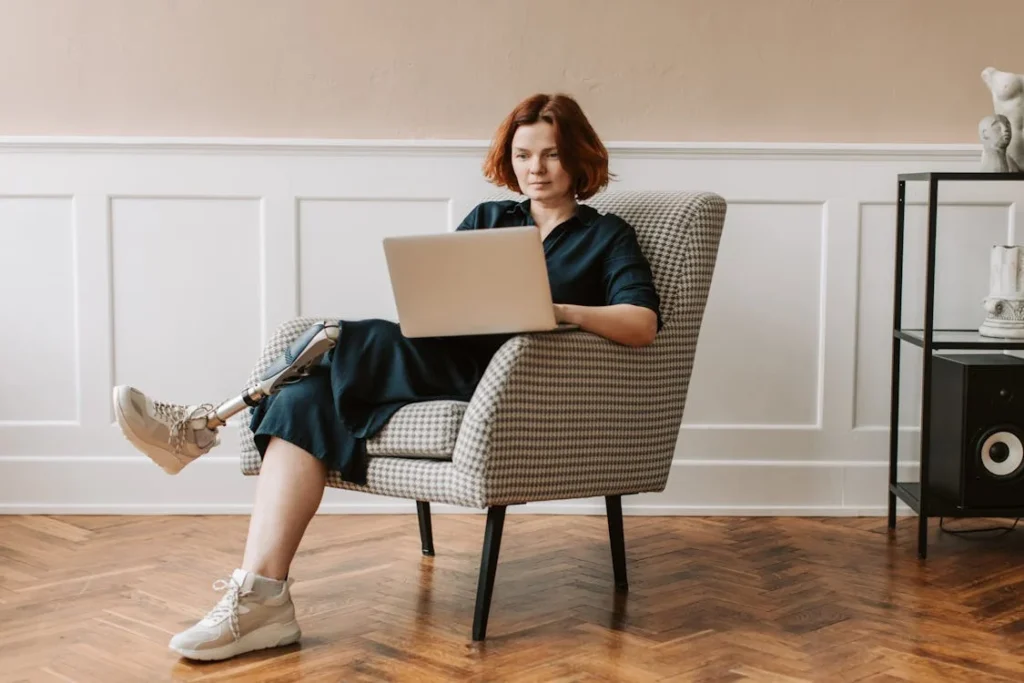Losing a part of your foot changes how you move through the world. It can affect your balance, the way you walk, and even how confident you feel taking each step. But here’s the good news — with the right prosthetic footwear, you can regain much of that lost stability and freedom.
At Robobionics, we understand the challenges that come with partial foot amputation. Whether it’s the loss of toes, the front of the foot, or more, the impact on day-to-day life is real. But so is the solution. Specialized prosthetic footwear, when designed and fitted properly, helps you stand stronger, walk better, and feel more in control of your movement again.
We’re not just talking about any kind of shoe. Prosthetic footwear for partial foot amputees is built with care and precision. It gives your foot the support it needs, helps with balance, and even reduces pressure on sensitive areas. This kind of support makes a big difference — not just physically, but mentally too.
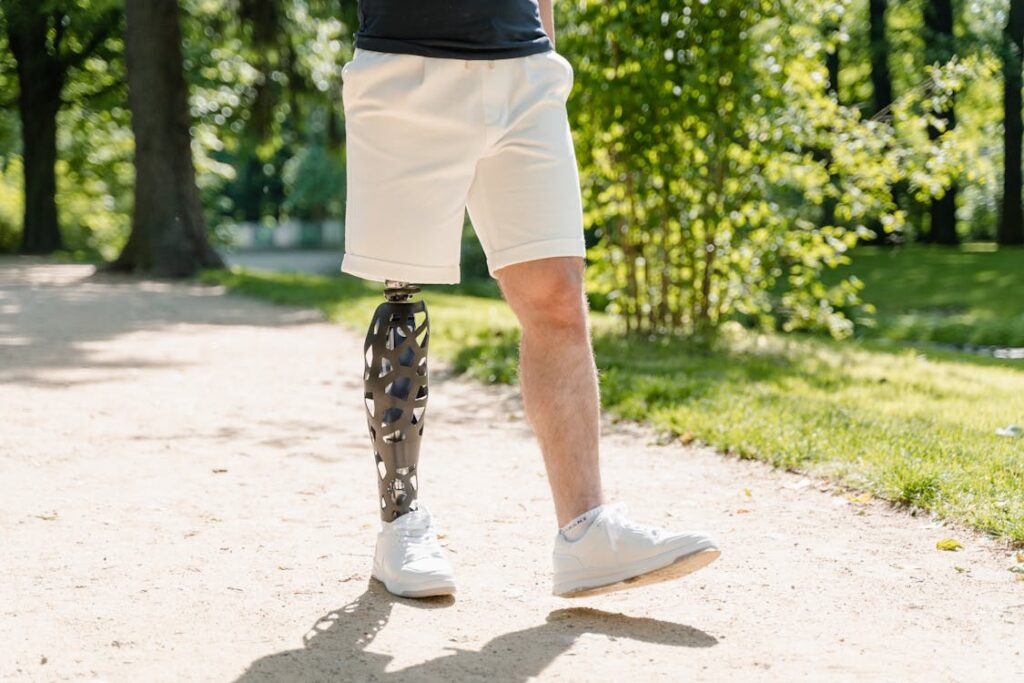
Understanding the Challenges of Partial Foot Amputation
Partial foot amputation can affect different parts of the foot — from a single toe to the entire front section. The exact impact depends on how much of the foot is removed, but one thing remains true for everyone: it changes how you move.
The foot plays a big role in balance, shock absorption, and push-off while walking. When a part of it is lost, your body has to adjust, often in uncomfortable ways.
Loss of Natural Balance
The toes, especially the big toe, are responsible for helping you stay upright when you stand or walk. They help your body shift weight, keep you from tipping over, and allow for smoother movement.
When toes or the forefoot are missing, this natural balance is disrupted. You may feel unstable, especially on uneven ground or when moving quickly.
This instability can lead to more cautious movements, which might seem safer at first, but over time, they can cause other problems.
People may start leaning too much on one side or dragging their foot, which creates strain on the knees, hips, and back. It also increases the risk of falling.
Changes in Walking Pattern
Your walking style, or gait, relies on your foot structure. When part of the foot is gone, your body often tries to compensate in other ways.
You might notice that you walk with a limp or shift your weight differently. Without the right support, these small changes can turn into larger issues like joint pain or fatigue.
For example, if the front of your foot is missing, your ability to push off the ground with each step is reduced.
This makes walking more tiring and less efficient. Over time, these changes can also lead to muscle imbalance and soreness.
Pressure Points and Skin Problems
Another major issue partial foot amputees face is uneven pressure across the remaining part of the foot. With less surface area to support your weight, more pressure is placed on fewer spots.
This can lead to skin irritation, sores, and ulcers — especially if the person has diabetes or reduced blood flow in their feet.
Without a proper prosthetic solution, even simple daily activities like standing for long periods or walking a few blocks can become painful.
Over time, these skin issues can become serious, requiring medical attention or even further amputation.
Difficulty with Footwear Fit
Traditional shoes are not made to support a foot that has been partially amputated. They don’t offer the structure or padding needed to make walking comfortable or safe.
A shoe that’s too loose can cause slipping inside the shoe, while a tight one can add unwanted pressure. Either way, poor footwear can make things worse.
This is where prosthetic footwear comes in. It’s not just about covering the foot — it’s about restoring function, protecting the limb, and helping people move with confidence again.
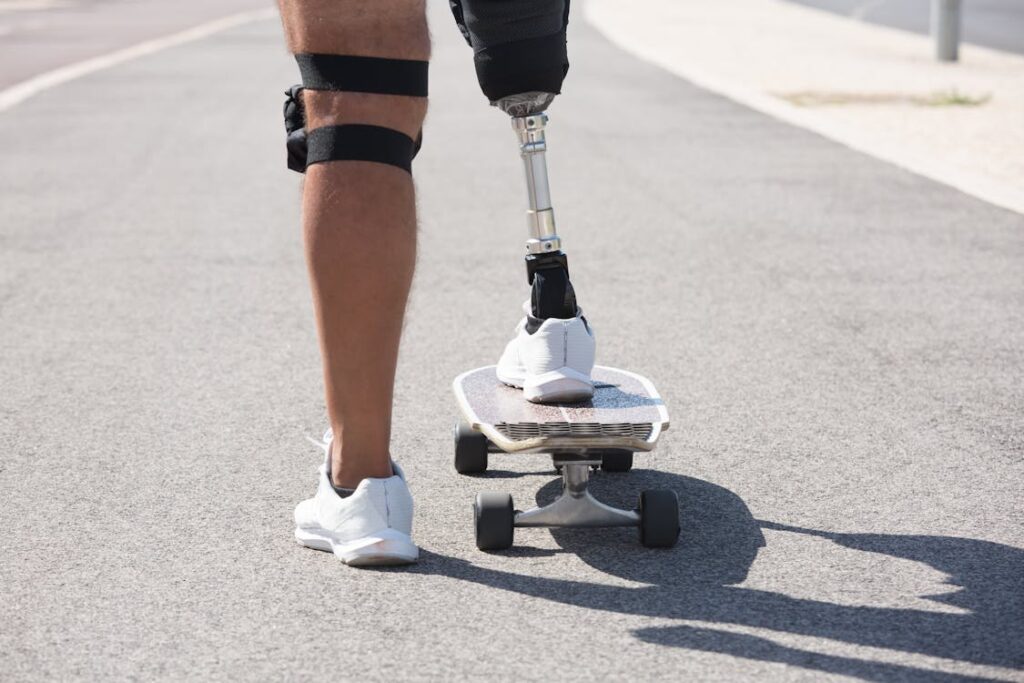
How Prosthetic Footwear Restores Stability and Balance
Prosthetic footwear does more than just fill the gap left by an amputation. It works with the rest of your body to help you move naturally and safely.
When designed properly, it becomes part of your movement, not just an add-on. For partial foot amputees, this support can be life-changing.
Redistributing Pressure for Comfort and Safety
One of the most important jobs of prosthetic footwear is spreading your body weight evenly across the remaining part of your foot. After an amputation, the weight that used to be supported by your toes or forefoot now gets pushed onto a smaller area.
This puts more stress on the skin, bones, and tissues that remain. Without the right support, that pressure leads to pain and sometimes serious injuries.
A good prosthetic shoe or insert helps avoid these problems by using soft, but strong materials that cushion the foot and shift pressure to safer areas. Custom-molded insoles, toe fillers, and special foot plates help make this possible.
They take into account your specific anatomy so that no single part of your foot is doing all the work.
At Robobionics, we work closely with you and our clinic partners to make sure your prosthetic footwear fits exactly right. Every design is made with the goal of keeping you pain-free, supported, and confident in your steps.
Helping with Push-Off and Walking Strength
After a partial foot amputation, one of the biggest changes is the loss of push-off strength. Normally, your toes help push your body forward during each step.
Without them, your gait feels weaker, and you might feel like you’re dragging your foot instead of walking smoothly.
Prosthetic footwear for partial foot amputees is specially made to restore this missing function. Some shoes include a stiff rocker-bottom sole that helps roll your foot forward, taking over the job that your toes used to do.
Others use carbon fiber foot plates that add a spring-like effect when you walk, giving you an energy boost with each step.
These small additions make a big difference. They help you walk more naturally and reduce the extra effort your body uses to move.
Over time, this leads to better posture, less fatigue, and more stable movement — all of which add up to fewer falls and more independence.
Improving Posture and Body Alignment
When part of your foot is missing, your body has to adjust to stay upright. You might start leaning to one side or turning your foot at a different angle to keep your balance.
At first, these changes might seem harmless. But over time, they can throw your whole body out of alignment.
Back pain, knee problems, and hip strain are all common in people using the wrong type of footwear. The body simply wasn’t meant to move with these imbalances.
A well-made prosthetic shoe fixes this by helping your foot stay in the right position. It supports the arch, keeps your heel stable, and helps your body stack properly from the ground up.
This alignment helps reduce pain, improve your posture, and even make standing for long periods more comfortable.
When your feet are supported correctly, your whole body benefits. That’s why choosing the right prosthetic footwear is not just about comfort — it’s about long-term health and mobility.
Regaining Confidence in Movement
When people feel unsteady on their feet, they start holding back. They avoid walking long distances, stop going out as much, and may even avoid social situations because of fear of falling or discomfort.
This loss of confidence can be just as hard to deal with as the physical pain.
The right prosthetic footwear changes that. It gives you a firm base to stand on and smooths out your steps so you feel safe again.
With better stability and reduced pain, walking becomes something you can rely on — not something you worry about.
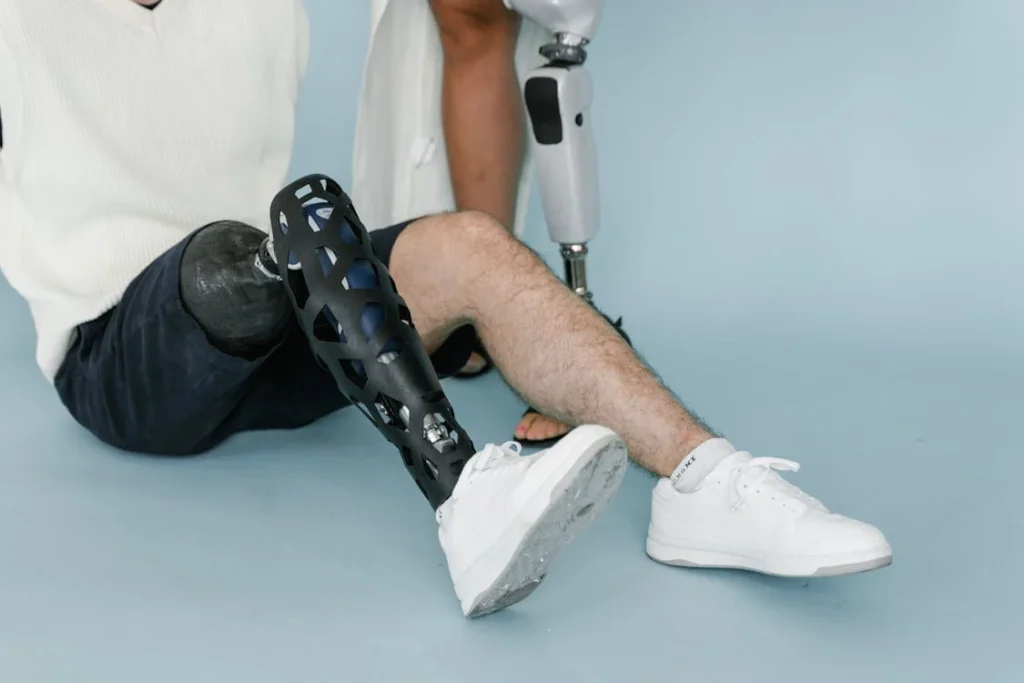
What Makes Prosthetic Footwear Different From Regular Shoes
You might wonder, “Can’t I just wear a comfortable, well-cushioned shoe?” It’s a fair question, and it’s one we hear often.
But here’s the key difference — prosthetic footwear is not just about comfort, it’s about restoring function that’s been lost. It’s carefully built to solve problems that regular shoes can’t address.
Designed to Match the Shape of Your Residual Foot
When someone loses part of their foot, the remaining part is rarely flat or evenly shaped. It may have sensitive areas, scar tissue, or bony points that need special care.
Regular shoes are made in standard shapes and sizes. They don’t take these unique factors into account.
Prosthetic footwear, on the other hand, is made to match the shape of your foot exactly. It fills in the missing parts with custom-molded inserts or fillers, giving your foot a complete base to stand on.
This gives better support and helps avoid pressure points that can cause pain or injury.
At Robobionics, we take precise measurements of your foot and create personalized solutions that match your unique needs. You’ll feel the difference from the very first step.
Added Support Where It Matters Most
Regular shoes often lack the kind of structure needed after an amputation. They may feel soft at first, but they won’t give your foot the long-term support it needs.
Prosthetic footwear adds support in specific ways. This can include a reinforced sole that doesn’t bend too much, a high back to hold the heel in place, or extra ankle support to keep you stable.
Some designs also include a built-in toe filler that stops the front of the shoe from collapsing, which is important if you’ve lost your toes or forefoot.
These features work together to create a steady, balanced walking experience — something no standard shoe can truly offer.
Built for Long-Term Use and Wear
Let’s be honest — a lot of regular shoes aren’t built to last, especially if your walking style has changed. Uneven weight distribution, altered gait, and the need for more foot control can wear out regular shoes quickly.
Prosthetic footwear is built with stronger materials that can handle this. The outer sole is often more durable, the internal structure is firmer, and the design helps spread the pressure more evenly.
These aren’t just medical features — they’re practical ones. They make sure your shoe performs well for a long time.
And if something wears out or breaks? Robobionics offers repair and maintenance services through our partner clinics like Omnify Prosthetics. That means faster fixes, local help, and no waiting months for imported parts.
Seamless Integration With Other Prosthetic Devices
Another advantage is that prosthetic footwear can work alongside other prosthetic devices. For instance, some users may need a partial foot prosthesis or foot orthosis.
Prosthetic footwear is designed to accommodate these devices, helping everything fit together smoothly.
This kind of integration is essential. If your shoe doesn’t work well with your other prosthetic components, you’ll feel it — in the form of discomfort, poor fit, or even injury.
That’s why Robobionics always takes a holistic view of your needs. We don’t just look at your foot — we look at your entire movement pattern and build a solution around it.
Personalized Fitting Process Makes All the Difference
The best part about prosthetic footwear? It’s never one-size-fits-all. At Robobionics, our process starts with a personal evaluation where we assess your residual limb, your activity level, and your mobility goals.
Based on this, we create a plan that includes fitting, trials, and home-based rehabilitation.
Our gamified rehab programs make it easier and more fun to adapt to your new footwear. These activities are designed to strengthen your muscles, improve coordination, and help your body adjust to the new way of moving.
You’ll feel more in control, and your confidence will grow with each step.
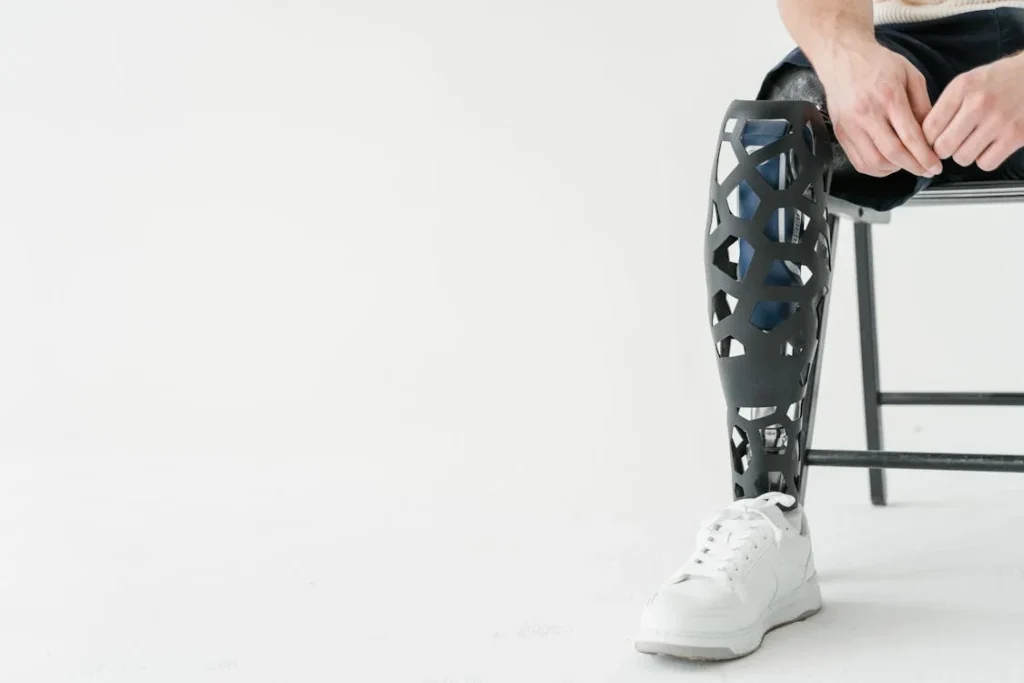
Choosing the Right Prosthetic Footwear: What to Look For
Getting the right prosthetic footwear is not just about filling the gap left by amputation. It’s about making sure your daily life becomes easier, more comfortable, and more stable.
Choosing wisely can mean the difference between struggling through each day and walking with confidence. At Robobionics, we help guide you through this process, making sure you understand what really matters when selecting your footwear.
Fit Comes First
The number one rule? It has to fit just right. A good fit means more than just choosing the right size. It means the shape of the shoe matches the shape of your foot — including the part that’s still there and the part that’s missing.
If the shoe is too loose, it can move around and create friction. That can lead to skin irritation, blisters, or even open wounds. If it’s too tight, it can press on sensitive areas and make walking painful. Neither of these options work.
At Robobionics, we custom design every solution. Whether it’s a molded insole, a toe filler, or a full prosthetic insert, it’s shaped to match your foot perfectly. That means better comfort, better balance, and better results.
Stability and Support
Look for footwear that keeps your foot stable and supported throughout your stride. This means a firm heel counter, a wide base for standing, and extra reinforcement in areas that take the most pressure.
If your toes or forefoot are missing, you’ll also need a solid rocker-bottom sole or a stiffened footplate to help with forward motion.
These small design choices make a huge difference in how you move. They help guide your foot from heel strike to toe-off — even if your toes are no longer there.
The result is smoother movement, less limping, and fewer chances of stumbling.
This is one of the areas where Robobionics truly shines. Our prosthetic footwear is engineered to support natural walking, even in complex cases of amputation.
We don’t offer generic options. Everything is tailored to fit your body and lifestyle.
Lightweight Materials for All-Day Comfort
Heavy shoes can make walking harder, especially when you’re adjusting to a prosthetic insert or filler. That’s why we use lightweight materials that provide support without weighing you down.
This is especially important if you’re active, on your feet for long hours, or just starting your rehab journey.
A lighter shoe reduces strain on your legs and makes it easier to move freely. But light doesn’t mean weak — our materials are strong enough to handle daily wear while keeping your step light and easy.
Easy to Wear and Remove
We know that after an amputation, even getting dressed can take more time. That’s why we make sure prosthetic footwear is designed to be easy to use.
Features like wide openings, adjustable straps, and smooth interiors make it easier to put on and take off your shoes without discomfort or stress.
For people who may have limited hand function or mobility challenges, these small details matter. They give you independence and save time every day.
This is something we always consider during your evaluation at Robobionics.
Works With Your Lifestyle
Everyone’s needs are different. Some people need footwear for walking long distances. Others need support for standing at work.
Some want a shoe they can wear while playing with their kids, doing light exercise, or simply going for a walk in the park.
This is why the “right” footwear is always based on your lifestyle. During your assessment at one of our partner clinics, we’ll ask about your daily routine, your goals, and any challenges you’ve faced with past solutions.
Then we’ll recommend a design that fits your life — not just your foot.
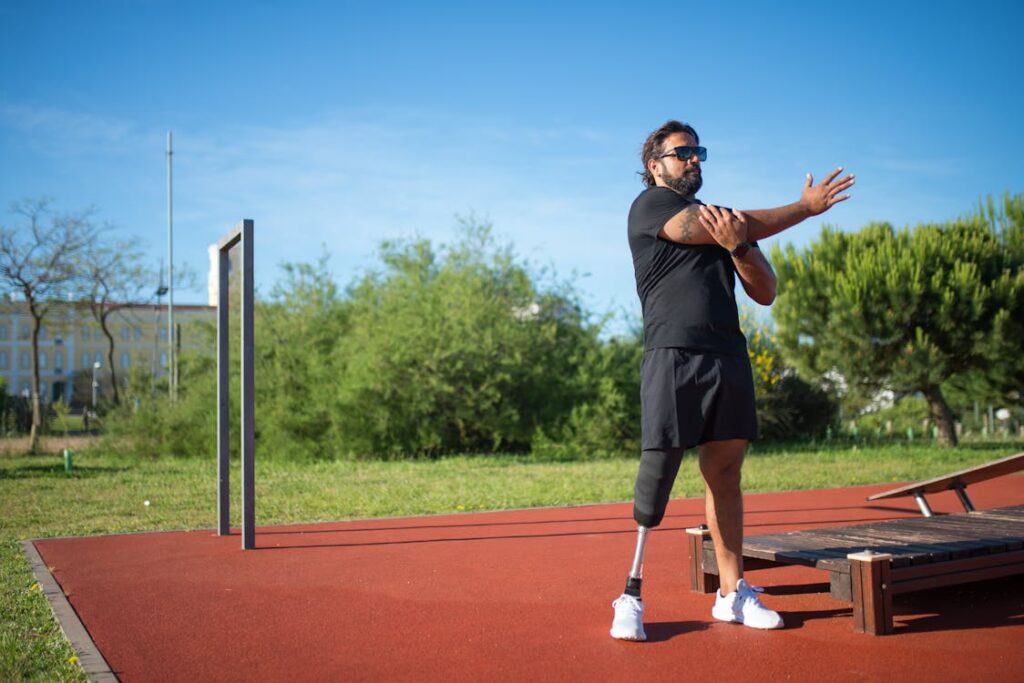
The Role of Rehabilitation in Enhancing Stability with Prosthetic Footwear
Getting the right prosthetic footwear is a major step, but it’s only part of the journey. The other part — and just as important — is rehabilitation. After a partial foot amputation, your body needs time and practice to adjust.
Muscles have to relearn movement patterns, your brain has to build new balance signals, and your foot needs to adapt to its new shape and support system. That’s where rehab plays a key role.
At Robobionics, we go beyond just fitment. We believe in complete care, and that includes offering gamified home-based rehabilitation programs designed to improve balance, build strength, and help you feel fully confident on your feet again.
Why Rehab is Essential After Getting Prosthetic Footwear
After surgery, most people are eager to get back to normal life. But it’s important to understand that stability doesn’t come back overnight. Even with perfectly fitted prosthetic footwear, your body needs training to use it well.
Without rehab, some people continue walking in ways that cause strain, discomfort, or even further injury.
For example, if you’re favoring one side too much, your hips and knees may absorb more pressure than they should. Over time, this can cause pain or alignment problems.
The right rehab exercises help fix this by teaching your body better movement habits. They strengthen the right muscles, improve posture, and help you move more naturally.
Rehabilitation also helps you build trust in your prosthetic footwear. Many people hold back after an amputation because of fear — fear of falling, fear of pain, or just fear of doing things the “wrong” way.
Structured, guided rehab breaks down those fears step-by-step.
What Makes Gamified Rehab Different
Traditional rehab often includes basic movements and repetition. But let’s be honest — it can feel dull and hard to stay motivated.
That’s why Robobionics developed a gamified rehab experience that’s simple, fun, and effective.
Our home-based rehab program includes interactive exercises that are designed like games. Each task is focused on improving a specific skill, like balance, coordination, or ankle strength.
The more you do it, the better your scores — and the stronger and more stable you become.
Gamified rehab helps in three important ways. First, it keeps you engaged. When rehab feels like a game instead of a chore, people stick with it longer. Second, it offers real-time feedback.
You get to see your progress, and that builds confidence. And third, it’s easy to follow. Whether you’re at home or traveling, you can do the exercises on your schedule.
This kind of flexibility is especially important for people who may not live near a clinic or can’t travel often. We bring the training to you, making rehab more accessible for everyone.
Combining Rehab with Personalized Support
Another key part of Robobionics’ approach is staying connected. You’re never left alone to figure things out.
After your prosthetic footwear is fitted, our team stays in touch to guide your rehab and make sure everything is working well.
If something feels off, we adjust it. If your strength improves and you’re ready for more advanced movement, we modify your rehab plan. Every user has a different pace, and we’re here to support you through yours.
This ongoing support also includes repair and maintenance of your footwear. If the insert starts to wear out or the fit changes as your body adjusts, we’re just a call away.
Since our solutions are made in India, you don’t have to wait weeks or months for replacements or fixes. Our local service network makes care faster and more reliable.
We know that using prosthetic footwear is a daily part of life. That’s why we treat it as more than just a product — it’s a complete support system designed to help you move, grow, and thrive.
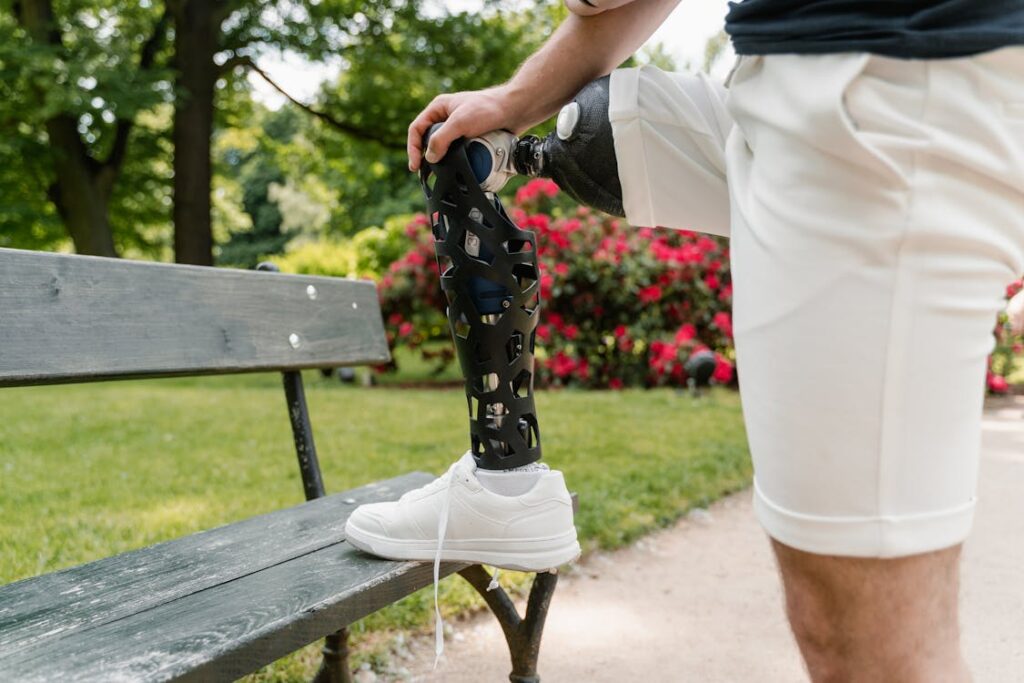
Long-Term Benefits of Proper Prosthetic Footwear for Partial Foot Amputees
Once the right prosthetic footwear is in place and supported by proper rehabilitation, something incredible begins to happen — daily life starts to feel normal again.
The small things that once felt difficult, like walking across the room, climbing stairs, or standing for long periods, become easier.
Over time, these improvements grow into long-term physical, emotional, and social benefits that completely reshape your experience.
At Robobionics, we’ve seen how the right footwear and care can restore confidence, improve health, and allow people to return to the life they want to live.
Restored Independence and Confidence
One of the most powerful changes that comes with stable movement is the return of independence.
After a partial foot amputation, even simple tasks like walking to the market, playing with children, or going out for work can feel uncertain. That uncertainty takes a toll, and many people stop doing the things they once loved.
But with proper prosthetic footwear, you feel supported in every step. It’s not just about standing or walking — it’s about knowing you can trust your body again.
That kind of confidence helps people get back to work, join social events, or travel with peace of mind.
We hear stories every day from users who share how they went from feeling limited to feeling liberated. This isn’t just physical progress — it’s emotional recovery, too.
Being able to participate in life again, without hesitation, changes everything.
Better Long-Term Joint and Muscle Health
One of the hidden dangers of poor footwear is the stress it puts on the rest of the body. When your foot isn’t supported properly, your knees, hips, and spine step in to help — but they’re not built to carry that load forever.
Over time, this imbalance leads to joint pain, muscle fatigue, and even long-term injuries.
Prosthetic footwear that fits well prevents this chain reaction. It helps you walk more evenly, keeps your weight distributed properly, and reduces the chance of straining other parts of your body. It’s like giving your whole system the right tools to work together.
At Robobionics, we build each solution not just for today’s comfort but for tomorrow’s health. Our design and rehab programs help strengthen your entire lower body and reduce the chances of future issues.
Lower Risk of Falls and Injuries
Falls are a serious risk for people with limb loss — especially if they don’t have the right support. The uneven pressure, balance shifts, and loss of foot control all add up to an increased risk of slipping or stumbling.
One bad fall can undo months of recovery and create fear that holds people back.
Proper prosthetic footwear lowers this risk. By giving you a stable, well-balanced base and helping you walk naturally, it reduces the chances of missteps.
Combined with regular rehab, it also improves your body’s reaction time and strength, which are key to catching yourself if you do trip.
We’ve seen people go from needing assistance at every step to walking independently across different surfaces and even returning to light sports or work.
This kind of progress doesn’t happen overnight, but it’s absolutely possible — and it starts with the right support under your feet.
Stronger Community and Emotional Wellbeing
When people feel better physically, they open up emotionally. They reconnect with friends and family, become more active in their communities, and feel proud of their progress.
This emotional strength is one of the most overlooked but important benefits of prosthetic care.
We often say that mobility isn’t just movement — it’s connection. When you’re able to move comfortably, you go out more, participate in group activities, and feel like yourself again. It reduces isolation and brings joy back into daily routines.
Robobionics also supports community building through our CSR initiatives, where we provide opportunities for people with disabilities to train, work, and grow.
We’re proud to create a positive cycle — where improved mobility leads to better lives, and better lives inspire others.
A Step Towards Self-Reliance and Dignity
For many partial foot amputees, the journey isn’t just about walking again — it’s about reclaiming their dignity. In India, where imported prosthetics can be expensive and hard to maintain, Robobionics is proud to offer Make in India solutions that are affordable, accessible, and built for local needs.
Our prosthetic footwear isn’t just functional — it’s a symbol of self-reliance. It means users don’t have to depend on foreign suppliers or wait months for a repair.
They get fast service, trusted local support, and solutions that fit their lives.
And most importantly, they regain control — over their health, their movement, and their future.
Conclusion
Living with a partial foot amputation doesn’t mean giving up comfort, balance, or independence. With the right prosthetic footwear, you can restore stability, move with confidence, and return to the activities that matter most. It’s not just about replacing what’s lost — it’s about unlocking new ways to move forward.
At Robobionics, we take a complete approach — from personalized fittings and advanced prosthetic design to gamified rehabilitation and ongoing support. Our mission is to help you walk stronger, live better, and feel like yourself again.
If you or someone you care about is navigating life after a partial foot amputation, we’re here to help.
Book a free demo of our prosthetic footwear solutions today and take the first step toward better mobility.
Want to see how gamified rehab can transform your recovery? Contact us now to learn more.
Let’s build a future where every step feels strong, stable, and full of possibility.



